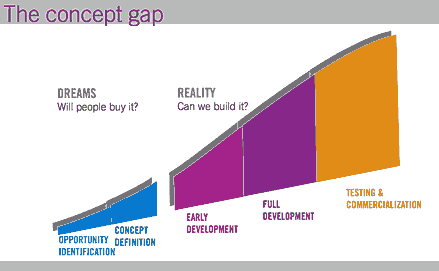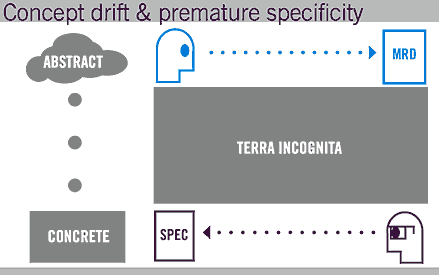The first student presentation I heard was Michael Winnick's "Crossing the Other Chasm: The perils of getting concepts into development". He opened with Geoffrey Moore's take on the technology adoption life cycle, where a chasm exists between early adopters and getting the product into the mainstream -- it's at this point that many products fail in the market. Michael turned the chasm focus inward...

His basic thesis is that if we can successfully cross the product development chasm, we can be more confident that we will cross the technology adoption chasm. He identifies the crux of the problem as a gap between the marketers and the engineers, where the marketers develop a requirements document full of features and great ideas, but the engineers need to develop a specification that precisely labels how the thing will work, and the two are never well reconciled. Marketers need to get more concrete, and engineers more abstract, so they can meet up in the middle and ensure that ideas flow successfully.

Michael works at Gravity Tank, an impressive product research and design firm, and listed 7 steps that they've found helpful in navigating these murky waters:
1. Accept change
2. Reduce barriers to actual users
3. Get everybody together
4. Prototype in low fidelity
5. Embody research, donít report it
6. Make decisions explicitly
7. Validate embodied concepts
The first two are obvious. The third is about getting all members of the team, be they engineers, marketers, business owners, designers, whoever, in the room together, collaborating. The fourth addresses how they can collaborate -- give everyone simple tools for prototyping solutions -- tap the latent creativity in folks whose lives are mired in Outlook and PowerPoint.
The fifth point resonates with the work we do at Adaptive Path. About the least useful deliverable is the Lengthy Report that Sits On A Shelf. To the degree possible, put your research in action -- it will ensure adoption by the developers.
